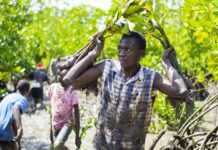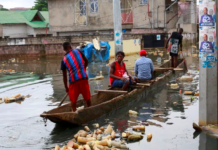By Roseleen Nzioka
Nairobi, Kenya: Kenya remains vulnerable to frequent climatic shocks that pose significant economic risk. Inaction against climate change could result in up to 1.1 million additional poor Kenyans by 2050 in a dry and hot climate future scenario.
These remarks are contained in the first-ever Kenya Country Climate and Development Report by the World Bank, launched in Nairobi today.
“Without adaptation measures, the impact from climate change could not only disproportionately affect the poor, but also result in real GDP losses of up to 7% from the baseline by 2050,” the report says.
Kenya is a relatively low emitter of greenhouse gases (GHGs) generating less than 0.1%of global GHG emissions although its emissions have more than doubled since 1995.
The inaugural report notes that not acting to address climate change will set back Kenya’s poverty reduction gains and increase inequality.
Kenyan households are already experiencing the effects of climate change. To cope with climate and other shocks, 37% of affected households reduce food consumption and 33% look for additional income sources, taking a toll on Kenya’s human capital, according to the report.
Multiple key sectors critical for Kenya’s economic transformation are also impacted by climate change. Today, 70% of disasters from natural hazards are attributable to extreme climatic events.
The report further notes that a considerable portion of public infrastructure is vulnerable to hazard risk. Kenya’s largely rain-fed agriculture and pastoral systems are highly vulnerable to climate change.
Heat stress from increased temperature due to climate change is expected to impact outdoor labor productivity (e.g., low-skilled and agricultural labor) the most. Furthermore, death and illness due to malaria and waterborne diseases are expected to increase by 56% and 10% respectively by 2050.
According to the Government of Kenya’s updated (Nationally Determined Contributions) NDCs, the costs of climate action were estimated to be $62 billion by 2030. By maintaining a low-carbon growth path, Kenya could contribute to the global decarbonization agenda and become more competitive in green markets and low-carbon supply chains.
“The Africa Climate Summit’s Nairobi Declaration committed to propelling Africa’s economic growth and job creation in a manner that not only limits emissions but also aids global decarbonization efforts,” said Kenya’s Cabinet Secretary for the National Treasury and Planning, Professor Njuguna Ndungu.
“This Country Climate and Development Report is an important first step in defining a resilient and low-carbon development growth path that could help Kenya leapfrog traditional industrial development and foster green production and supply chains,” said Prof Ndungu.

Cabinet Secretary for Climate Change and Forestry Ms. Soipan Tuya said the World Bank report was timely as it clearly outlines key action areas following in the footsteps of the recent Africa Climate Summit held in Nairobi in September which was a call to action by all stakeholders.
Speaking at the same function Cabinet Secretary for Roads and Transport Mr. Kipchumba Murkomen, said that the World Bank report was a “forward-looking” document with predictions of climate change going to the year 2100. He said transport was one of the major contributors to carbon emissions in Kenya but the government was on track to establish mass commuter transport systems that would greatly reduce carbon emissions.
Mr. Murkomen disclosed that infrastructure emergencies and disasters that are occasioned by climate change eat into the resources meant for development and planned maintenance. The data in the report, he said would serve in reviewing of redistribution of resources within the ministry.
Ms. Nasra Nanda, the CEO of Kenya Green Building Association challenged stakeholders to identify the gaps, besides financing.
“What are the gaps? Financing is not the issue but the purpose for the finance,” said Ms. Nasra adding that County governments must also be roped in and play their part.
Ms. Sellah Bogonko a youth advocate and Co-founder and CEO of Jacob’s Ladder Africa decried the gap between academia and industry saying skilling and upskilling of manpower were urgent.
Ms. Bogonko challenged big polluters to take full responsibility for their damaging actions and the government to create targeted education in climate change adaptation and a “value-chain” approach to education.
The Kenya report finds that a higher average annual GDP growth rate can buffer the impact of climate change on GDP, lowering the impact of climate on GDP (reducing it by 2.78–5.3% in 2050 compared to the baseline), but cannot eliminate the risks.
The report outlines five key action areas for inclusive, climate-resilient and low-carbon growth in Kenya:
- Improving management of water, land, and forests to boost climate-resilient agriculture and rural economies;
- Fostering people-centered resilience with climate-informed basic services and urbanization;
- Strengthening Kenya’s competitiveness in international markets through shifts in energy, transport, and digital systems;
- Improving Integration and coordination of climate action in policy, planning, investments, and decision-making across the economy;
- Implementing policy measures that mobilize climate financing from the private and public sectors.
Effective implementation of these multisector action areas requires a whole-of-economy approach to sustain climate action at scale. Strong coordination and prioritization of vulnerable areas and people will be imperative. It will require subnational government, national government, private sector, academia, non-governmental organizations, donors, and communities to collaborate and innovate together.














